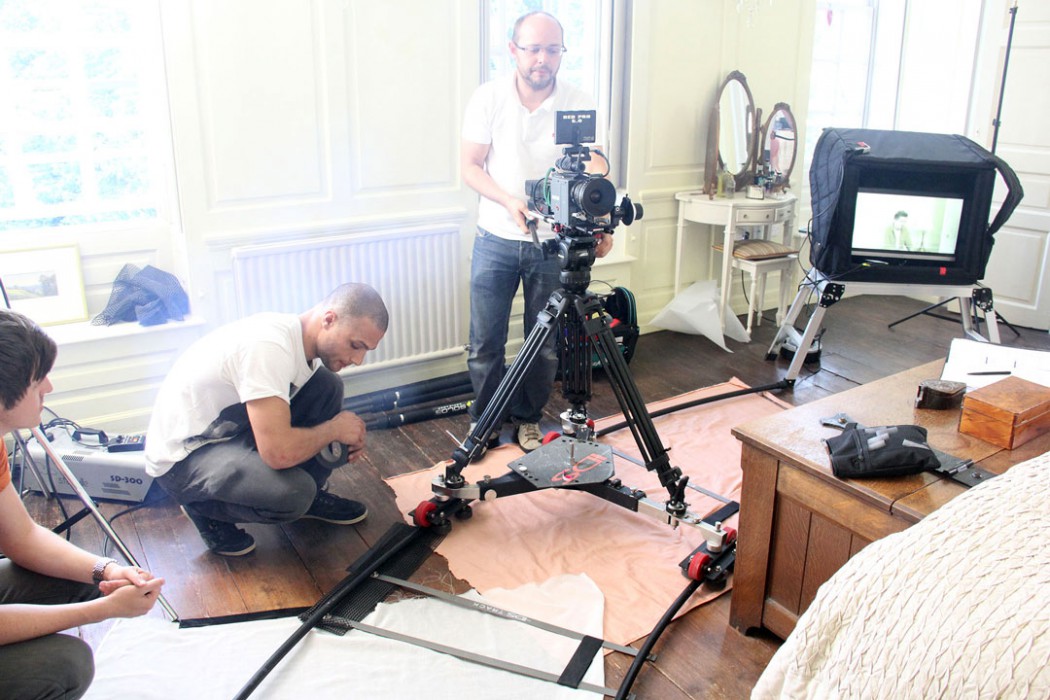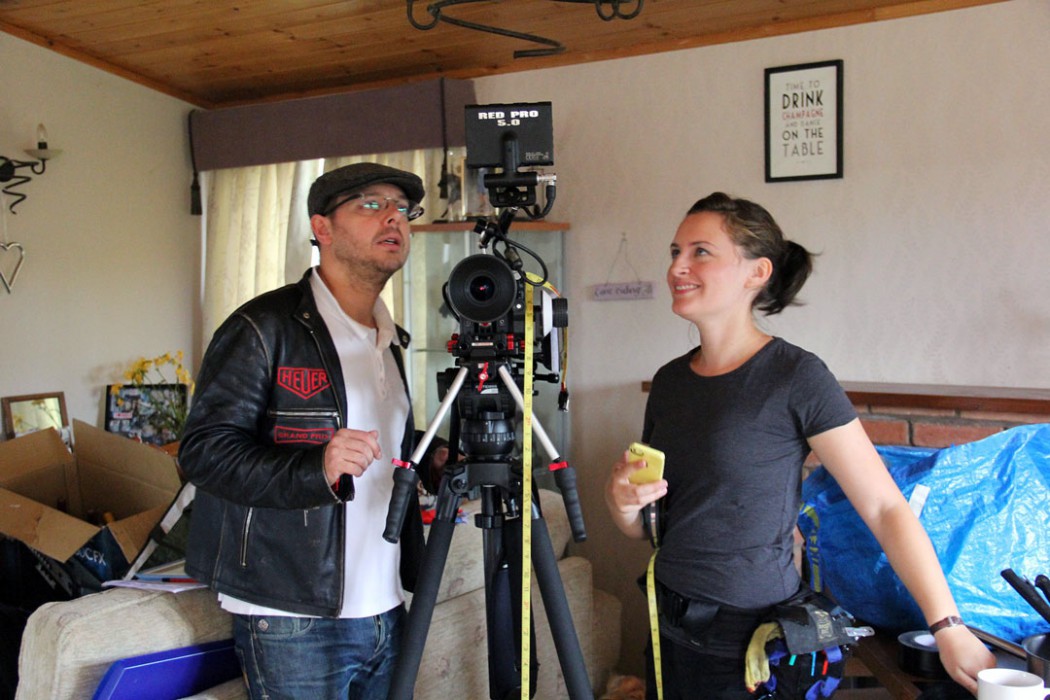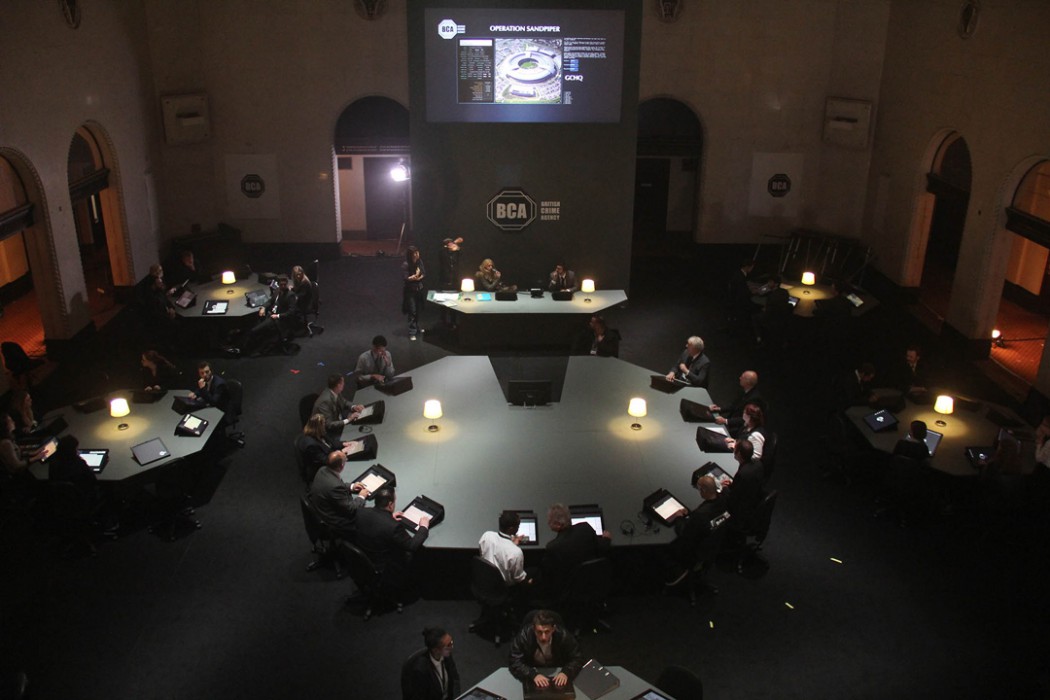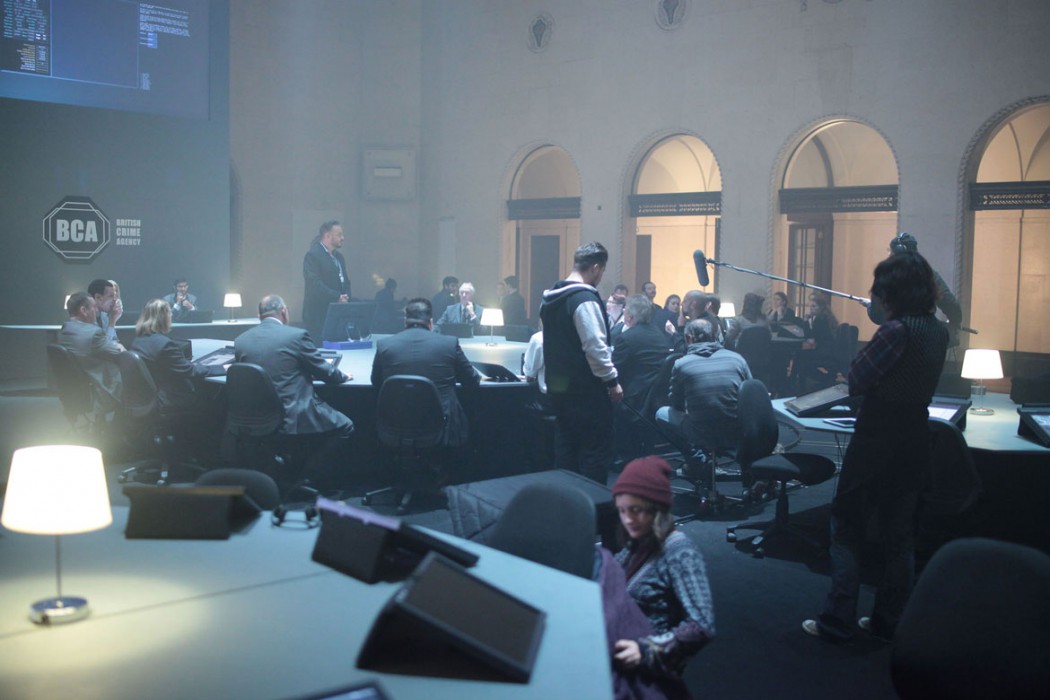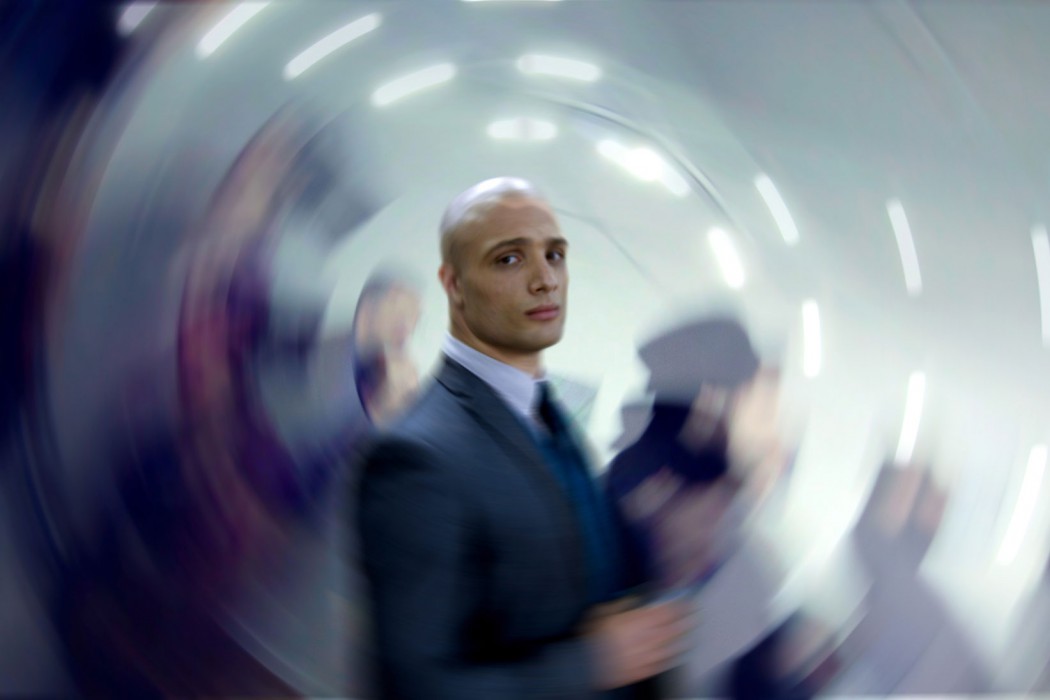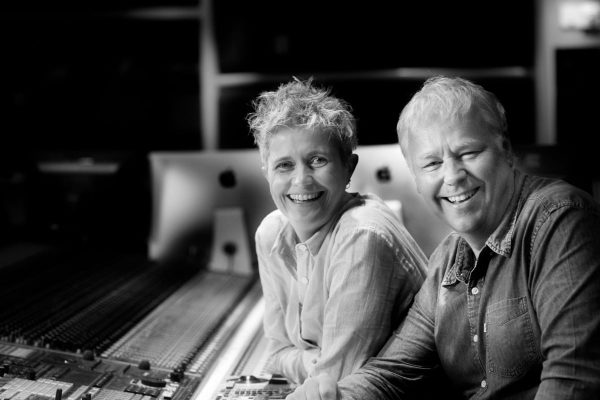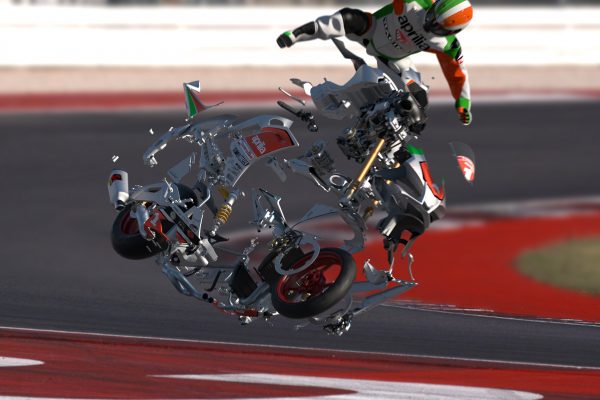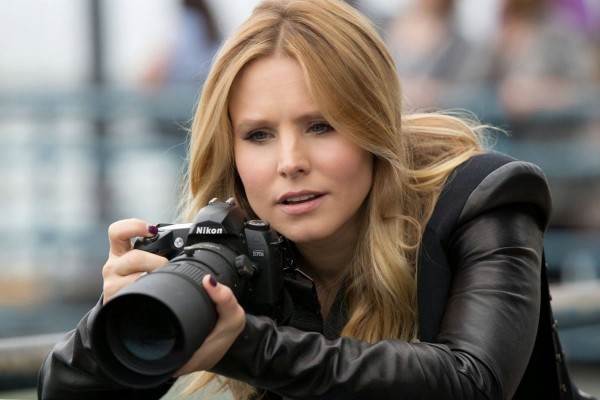Last month we featured an image on our Facebook page and E-News of a Canon 5D attached to a motorised grinder. The image was popular to say the least and managed to gain the attention of UK filmmaker Tom Lawes aka the director who created that DSLR nightmare-rig for his latest feature Monochrome. The results of shooting on the grinder, as you can see above, are pretty spectacular.
Interview By Nicole Boyd
At the time Lawes told the V&F Facebook community that despite using a RED Dragon throughout much of the principal photography, he needed a background FX plate for just one shot:
“I had the idea of creating a hi-speed rotating rig. Due to the weight, we didn’t want to risk one of our REDs rotating at 600rpm so I had a friend build this rig to house an old Canon 5d. The rig is also mounted on a dolly so as the camera builds up speed, it also moves forward. Thanks to the 5d’s rolling shutter effect, the end result looks somewhat like a kaleidoscope. In the final film, the lead character who has the unusual condition of synesthesia, will be composited on to the spinning background as he stands agog, mesmerised by a beautiful painting. There is also a reverse shot of the background spinning with the painting remaining stationary on the wall. Incidentally, the rig would have spun at 3000 rpm but we were explicitly told by the man who built it ‘not to go there’!”
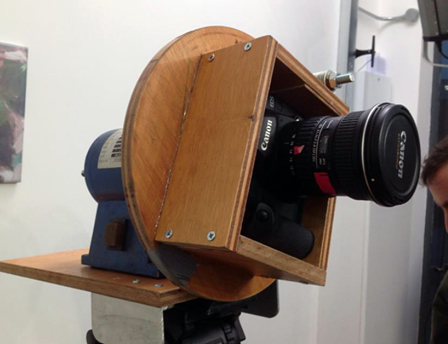
Yes, that is a 5D attached to a grinder motor! Everyone, stand clear!
The film the rig was created for, Monochrome, tells the story of Emma, a disillusioned young woman who flees to the countryside after her boyfriend is arrested. Relying on casual work from wealthy landowners to survive, she reacts against her indentured servitude with extreme violence. A brilliant detective with the unusual neurological condition of synesthesia, is hired to hunt Emma down.
The film stars newcomer Jo Woodcock (Land Girls, Dorian Gray) and singer songwriter Cosmo Jarvis, alongside a supporting cast which includes BAFTA winner James Cosmo (Game of Thrones, Braveheart), Patrice Naiambana (Son of God, Highlander: The Source), Lee Boardman (London Boulevard, Jack & The Giant Slayer) and Steve Jackson (Coronation Street).
We spoke to Tom to find out more about his film, his career and that photo!
Here’s what he had to say:

Tom Lawes (right) on location with James Cosmo shooting Monochrome
Can you tell us about your previous work on the acclaimed documentary The Last Projectionist?
I own the UK’s oldest working cinema, The Electric in Birmingham, and coming up to the centenary in 2009 decided to interview ex staff and customers about their memories of the building and cinemas in general. As the footage found a lot of interest, including a feature on BBC Worldwide, I decided to expand the project into a feature length doc, focusing on the projectionists and the end of 35mm in theatres.
I started the project on a Sony EX1 but later moved onto a Canon 5d and 7d. The arrival on these shallow DOF cameras were the catalyst for creating a theatrical documentary as it became possible to shoot footage that looked cinematic without, ironically enough, spending a fortune on 35mm film.
‘The Last Projectionist’ was completed in 2011 and was exhibited in festivals around the world and went on to play over eighty cinemas commercially in the UK.

Tom Lawes (in the hat) on location with James Cosmo shooting Monochrome
Where did you come up for the idea for Monochrome (and the title)? Do you know anyone with synesthesia or do you have it yourself?
After TLP, I had planned on making a comedy inspired by real life events at the cinema. However, the development faltered as we had difficulty finding a casting director willing to take on the project. I wasn’t prepared to settle on a DIY cast, as I knew from owning a cinema that the performances, preferably by name actors, are vital to securing distribution. I’d long since learnt that the first thing cinema customers ask when enquiring about a new film is ‘who’s in it?’
In the meantime I decided to make a dramatic short about a young woman murdering rich people living in the English countryside called ‘3 Sides of the Coin’. During post production I came up with an idea expanding the project into a feature with a detective on her trail, inspired by classic noir thrillers. I liked the concept that the detective could be as much of a social outsider as the serial killer he was chasing, only his isolation manifested itself in a very different way.
I heard about synesthesia through reading about the artist David Hockney, who sees colours in response to music. He then uses the colours that he sees to inspire set design for Opera. Our detective Gabriel uses this unusual condition to help with his work, although it also exists as a metaphorical construct, leading us to believe he can perceive things that we can’t.
I also gave the character OCD to make him more difficult to live with and a tangible reason for his social awkwardness. Gabriel is supported through these challenges by a close relationship with his mother. By contrast, Emma the serial killer, is abused by her mother and becomes a violent sociopath.

“We dressed stunt woman Brenda Brummitt-Bourne in costume then taught how to hold the RED camera shortly before the stunt team dragged her at great speed down a corridor.
Great POV shot” – Tom Lawes
How did you go about getting producers/funding? Also did you use any crowdfunding/networking platforms for funding & crew roles?
I saved up over a couple of years to fund the film. I also had a small external investment from a family member. We did have some interest from distributors and sales agents but in the end we decided to go it alone as we had just about enough finance to cover principle photography. Not only did that save months/years of soul destroying development hell but it means that on completion of the film we will be in a much stronger bargaining position in the markets.
Also, we saved a big chunk of the budget using equipment we already owned. However, I did upgrade our RED MX cameras which cost an extra £20k or so.
Many of the crew we were already using on other projects. The rest were sourced locally by using the Electric Cinema’s social network. With cast, crew and extras around 150-200 people worked on the film during principle photography although the core crew was barely 20 of us.
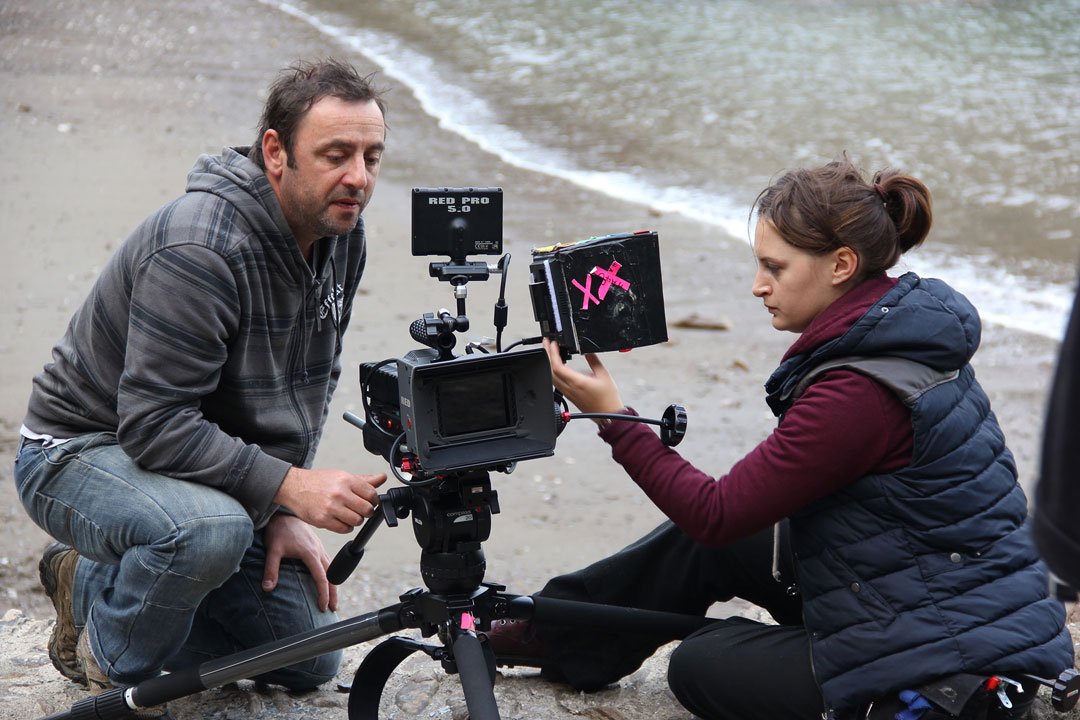
On the set of ‘Monochrome’ with lead camera operator John Charalambous and focus puller Lauren Hatchard
For Monochrome, what gear did you decide to shoot on and how long did principal photography take?
We shot on two RED Scarlet Dragons and shot at 5k 2:1, with the RED Raw codec working at 8:1. Final delivery of the film will be at 4k 2.4:1 so shooting at 5k and having a little extra resolution to crop the picture in post is massively useful. There’s been many times when we’ve captured a great performance but the framing is a bit off. Shooting on RED and being able to reframe can be a lifesaver.
I found an immediate improvement with the Dragon sensor over the MX. Not so much in low light, which I still have reservations around concerning chroma noise, but with the highlights that seem to roll of much more smoothly than before. You can really see the difference in the grade and I feel that RED now has a camera that can take on the Alexa in the latitude stakes.
I fitted one camera with the Motion mount which had its uses, especially when the camera was used with a DJI Ronin, but the inability to turn the ND filter completely off was a pain in low light. During the shoot we bought a second standard Canon mount and only used the Motion mount when we needed to ditch our matte box because of the weight. It took about 10 minutes on set to change the mounts so it worked out in the end.

Tom said, “the DJI ronin came in handy again on the end of this crane. Note the bubble wrap to avoid us damaging the ceiling in this millionaire’s mansion in central England. In this location we had 800w red head tungsten lights too close to the skylight and managed to melt and crack the glass.
That was a bit more of the contingency budget down the drain.”
We had one of the first Ronin’s in the UK and used it pretty much every day. It was very heavy and could only be held for a few moments before the camera operator verged on a mild heart attack so in the end we fitted it to an old Glidecam vest/arm we had kicking about. We got some great results though that we couldn’t have achieved without it so I shouldn’t moan!
We also fitted the Ronin to a 4m jib which allowed us to remote control the camera whilst simultaneously smoothing out any moves that often curse cheap, manual jib arms.
We used Zeiss CP2 lenses (21mm, 35mm, 50mm, 85mm and 135mm) alongside an 11-16mm Tokina and Canon 70-200 stills zoom with their 2x extender. The 70-200 is also useful for macro when fitted with a cheap set of rings bought off ebay.
We also used the Red Rock remote focus and the Paralinx wireless which was great quality, and fantastically light but also very flimsy and required emergency soldering on more than one occasion.
We filmed for nearly 7 weeks including some prep days and we still have a few days left to shoot in January as Jenny Agutter unfortunately dropped out due to scheduling conflicts with Call the Midwife and so we’re having to reschedule those scenes once we’ve recast.

The cobbled together rig which allowed filming a 360 degree shot using an 8mm stills lens.
We know about the spinning 5D, but were there any other customised gear items?
We made a near floor level rotating tripod for a 360 degree fish eye interior shot out of bricks and gaffer tape. Our lead camera operator also fashioned the Ronin/glidecam bracket out of some old pipe he found on set.
What’s the post production workflow like? You also mention compositing, are you using AE, Nuke, Maya or Fusion?
Well fortunately as the owner of a cinema, compete with a Da Vinci Resolve suite and 5.1 dubbing theatre in the basement, we’ll be able to complete most of the post in house. We recorded an orchestra for ‘The Last Projectionist’ in our main theatre although we had to do it section by section due to the size of the room. I’ll be composing the score once we have locked the edit, I hope in early spring.
We’re using the Adobe suite for the editing, Resolve for the grade with the VFX yet to be confirmed as that’s one job I’ll be handing over! The music and the sound mix will be completed in Steinberg Nuendo.
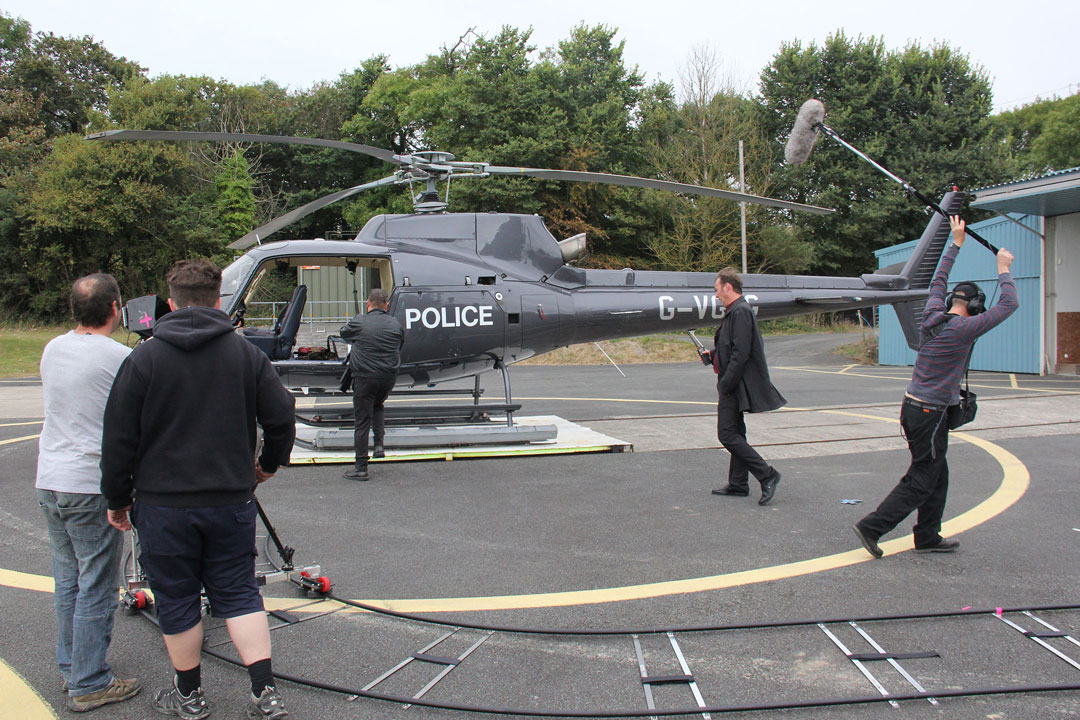
“We took the doors off a helicopter and flew it over the cliffs of Devon on the south coast of England. It was all fine until the wind suddenly rushed up from the cliffs and caught inside the helicopter nearly tipping us upside down. I nearly dropped one of our REDs 600ft into the sea and actor Lee Boardman nearly threw up. Even the very experienced ex Falklands War pilot thought we were finished.
I can laugh about it now but…” – Tom Lawes
How do you plan on releasing Monochrome?
As the post continues we’ll be talking to sales agents and should be able to establish the value of the film as it nears competition. I’ve been in the business for a long time and have no illusions as to how difficult it can be to sell an independent feature, especially internationally. My main focus at this point is to make the best job of it I can and hopefully create a film the cast and crew can be proud of.
So, what’s next for you?
I’ve just launched the world’s first greenfield film festival (think Glastonbury but with movie theatres instead of music stages) called Flickerama (www.flickerama.co.uk). The first one goes ahead in England during August 2015. I’m just hoping I can finish ‘Monochrome’ before then so I can take a holiday [next] September!
That will be a richly deserved holiday. To find out more about Tom’s work and his historic movie theatre, check out his film production company Electric Flix and Birmingham UK’s oldest working cinema The Electric.
You can watch the trailer for Monochrome below:
